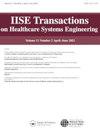联合健康状态效用值中偏好相互作用的重要性应用于共同决策的决策分析
IF 1.5
Q3 HEALTH CARE SCIENCES & SERVICES
IISE Transactions on Healthcare Systems Engineering
Pub Date : 2022-06-28
DOI:10.1080/24725579.2022.2095467
引用次数: 1
摘要
摘要健康状态效用值(HSUV)的直接推导是困难的,并且不一致的HSUV是一个普遍存在的问题。关节健康状况以不同的方式影响人们的生活质量。它们可以是偏好的替代品、偏好的补充,也可以是相互效用无关的。本文开发了一种新的模型,称为相关双变量伯努利健康效用(CBBHU)模型,用于从已知的单个HSUV和引发的JHSUV的一小部分中估计关节HSUV。针对JHSUV对严重程度的依赖性,开发了一个双变量健康效用函数(HUF)。它由组成的单个HUF和具有两个参数的双变量函数的乘积组成,这两个参数随健康状况和患者的偏好而变化。这些参数可以拟合到两个严重程度级别,参数化的HUF用于估计不同严重程度级别的HSUV。提出了一种需要显著减少引发的HSUV数量的bootstrap方法来估计三个或更多JHC的JHSUV。CBBHU函数满足Fréchet边界,并提供内部一致的HSUV。偏好互动会对患者的医疗决策产生重大影响。CBBHU值适用于共享决策应用程序。亮点CBBHU模型是一种用于估算JHSUV的新型理论模型。CBBHU模型为建模和预测可靠的JHSUV提供了一种实用的方法。JHSUV满足Fréchet不等式、效用理论和前景理论。CBBHU对作为偏好补充和偏好替代的JHC进行建模。一种实用的bootstrap方法将CBBHU模型扩展到多发性疾病。本文章由计算机程序翻译,如有差异,请以英文原文为准。
The importance of preference interactions in joint health-state utility values applied to decision analyses for shared decision-making
Abstract The direct elicitation of health-state utility values (HSUVs) is difficult, and inconsistent HSUVs are a prevalent problem. Joint health conditions (JHCs) affect people’s quality of life in different ways. They can be preference substitutes, preference complements, or mutually utility independent. This article develops a novel model called the correlated bivariate Bernoulli health-utility (CBBHU) model, for estimating joint HSUVs (JHSUVs) from known single HSUVs and a small subset of elicited JHSUVs. A bivariate health utility function (HUF) is developed for the dependence of JHSUVs on severity. It consists of the product of the constituent single HUFs and a bivariate function with two parameters that vary with health conditions and patients’ preferences. These parameters can be fitted to as few as two severity levels and the parametrized HUF used to estimate HSUVs for different severity levels. A bootstrap method that requires a significantly reduced number of elicited HSUVs is proposed for estimating JHSUVs for three or more JHCs. The CBBHU functions satisfy the Fréchet bounds and provide internally consistent HSUVs. Preference interactions can have a substantial impact on patients’ medical decisions. CBBHU values are appropriate for shared decision-making applications. HIGHLIGHTS The CBBHU model is a novel theoretical model for estimating JHSUVs. The CBBHU model provides a practical approach to model and predict reliable JHSUVs. The JHSUVs satisfy the Fréchet inequalities, utility theory, and prospect theory. The CBBHU models JHCs that are preference complements and preference substitutes. A practical bootstrap method extends the CBBHU model to multimorbidities.
求助全文
通过发布文献求助,成功后即可免费获取论文全文。
去求助
来源期刊

IISE Transactions on Healthcare Systems Engineering
Social Sciences-Safety Research
CiteScore
3.10
自引率
0.00%
发文量
19
期刊介绍:
IISE Transactions on Healthcare Systems Engineering aims to foster the healthcare systems community by publishing high quality papers that have a strong methodological focus and direct applicability to healthcare systems. Published quarterly, the journal supports research that explores: · Healthcare Operations Management · Medical Decision Making · Socio-Technical Systems Analysis related to healthcare · Quality Engineering · Healthcare Informatics · Healthcare Policy We are looking forward to accepting submissions that document the development and use of industrial and systems engineering tools and techniques including: · Healthcare operations research · Healthcare statistics · Healthcare information systems · Healthcare work measurement · Human factors/ergonomics applied to healthcare systems Research that explores the integration of these tools and techniques with those from other engineering and medical disciplines are also featured. We encourage the submission of clinical notes, or practice notes, to show the impact of contributions that will be published. We also encourage authors to collect an impact statement from their clinical partners to show the impact of research in the clinical practices.
 求助内容:
求助内容: 应助结果提醒方式:
应助结果提醒方式:


